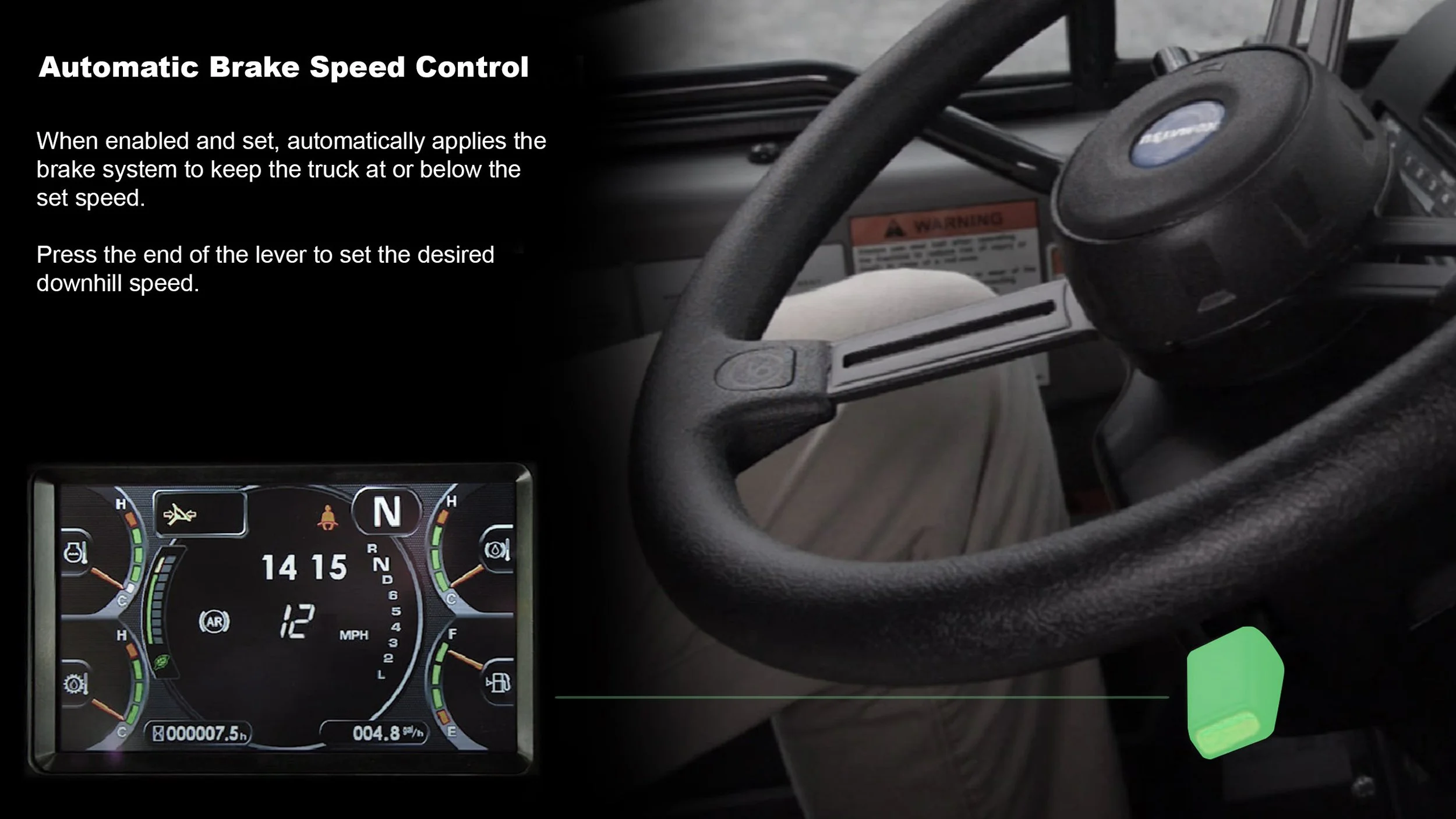HYBRID HAUL TRUCK ANALYTICS for MINE SITE DRIVER
PRODUCT DISCOVERY & FEATURE VALIDATION
SYNOPSIS
Analytics dashboard analyzing Driver performance as related to Hybrid Electric Mining Haul Truck.
COMPANY / CLIENT
First Mode
ROLE
Lead User Researcher | UI Design Mockup
CROSS FUNCTIONAL TEAMS
Product Management | Software Product Development | Project Management | Modeling & Simulation
First mode is an engineering product startup company aiming to decarbonize the mining industry. The approach is a hybrid diesel-electric program that converts existing diesel truck into hybrid electric vehicles. It does so by:
Capturing Electric Energy through regenerative braking - especially on downhill route portions.
The Captured Energy is then applied to assist the truck on uphill climbs, resulting in less Diesel Fuel consumption - thus Diesel Savings.
BACKGROUND & CONTEXT
Video by ©Camille Woodthorpe
PROJECT HYPOTHESIS +
PROBLEM STATEMENT
We know that the Mining Customers' ultimate goal is to cut down on diesel fuel consumption through the re-utilization of captured brake energy.
When we began the project, First Mode’s hypothesis is: Retraining driver behavior is the best approach to optimize brake energy capture. This led to a request to start development on a mobile analytics tool geared towards retraining driver behavior.
The product team and I understood that in order to address this project there are actually 2 view points to consider- Macro & Micro. We ended up turning viewpoints into 2 separate problem statements, each denoting a stage of the research process.
MACRO:
Though current focus to retrain drivers’ brake behavior, is there another approach that can better optimize brake energy capture?
MICRO:
Assuming driver retraining is the best approach, what are some of the behavior metrics and product features that is critical in retraining drivers.
RESEARCH GOALS + PLAN
The product team and I both understand that a Digital Analytics Dashboard is only part of the holistic solution. A 2-stage research plan reflecting the macro & micro viewpoints is devised in order to both better define the holistic solution while still pushing progress on the needed Driver Mobile Analytics Dashboard.
RESEARCH STAGES
To help better navigate & digest all the information, click on title to jump directly to the particular research stage
PRODUCT DISCOVERY - Macro Problem Statements
Validate that Driver retraining is the best way to optimize brake energy capture
Keep an open mind about other possible ways to optimize brake energy capture
FEATURE VALIDATION - Micro Problem Statement
Take the research findings from the Project Discovery phase and start identifying the critical metrics and features.
PRODUCT DISCOVERY
RESEARCH APPROACH
Goal of the Product Discovery should be to uncover the:
User's routines and contextual details related to their daily duties.
User scenarios, specifically understand the environments and conditions under which the drivers operate and how it may affect the possible solutions.
Possible solutions that can positively affect Driver's braking behavior. Real-time Feedback UI has been suggested as a possible solution to affect user behavior. Is it appropriate for the User?
Be on the lookout for other potential approaches to brake energy capture optimization
While drivers are a bit more accessible than mine leadership personnel, the user pool is still limited. To overcome the challenge, I applied the following mixed approach to combat this challenge:
Set up 10 qualitative interviews mixed of 2 groups
4 users are active drivers
6 users are a mix of internal stakeholders and mine personnel from a nearby Washington Mine, both groups have part-time driving experience.
Composed first drafts of the following visual research collaterals in order to expedite user understanding of the research topics during interviews. I created these frameworks for the Junior Researcher to use as we collectively paint a more holistic picture of the Service Design experience.
METHODOLOGY & COLLATERAL
-
Understand and empathize with the user, looking into typical traits & approaches to their responsibilities
Their context will help us understand how receptive & appropriate the various solutions are.
-
Visually outline the activities the User goes through.
Representation of Day | Week | Month in the life of User is like.
Provides conversation background to overlay various Hypothetical Solutions & simulate its effectiveness.
-
Illustrations help make proposed approaches more relate-able,
Show elements previously not considered
Start aligning with Modeling + Simulation on what things should be verified in the real world.
FINDINGS & ANALYSIS
User Persona & Characteristics
Work shift schedule is extremely packed
14 hour work days (shifts + commute) - only 45 min break total over 2 sessions
1 week day shifts, 1 day break, then immediate switch biological clock to 1 week night shift
1 week break, including flight travel home. Then 2 week shift starts again.
Thus Drivers' receptiveness to training varies immensely throughout their 3 week work cycle.
**Worth considering, think of Driver Training not as any single approach (in cabin display UI, desktop/mobile app) but as a holistic Driver's Education program tailor made to reflect Drivers' attention span.
Explore different methods suited for appropriate timing:
Simplified feedback - between daily shifts
Comprehensive feedback - between weekly shifts
Simulator Training - between monthly shifts
“Think of Driver Training not as any single approach, but as a holistic Driver’s Education program tailor made to reflect Drivers’ attention span.”
User Context
Staff Driver Safety is paramount to mines
equipment / process can easily turn fatal
unplanned downtime also costly to mine production
3rd party safety studies indicates
avoid unnecessary interfaces in drive cabin as it can be fatally distracting.
Therefore an In-cabin Real-time feedback analytics display is not a safe approach to optimize driver brake behavior
“Avoid unnecessary interfaces in drive cabin...(thus) in-cabin Real-time feedback analytics display is not a safe approach”
Possible Solution Approaches
There are 3 different ways to apply braking force:
Foot Pedal
Hand Lever
Automatic Brake Control
Augmenting Manual Foot or Hand brake application is the best short term approach optimize brake energy capture, but has the highest chance for driver error. We can minimize the user error through training and analytic feedback.
Augmenting Automatic Brake Control is the best long term approach to optimize energy capture because we can leverage engineering to program the optimal brake application. This does take longer to test and develop.
“Augmenting Automatic Brake Control is the best long term approach to optimize energy capture because we can leverage vehicle control computer while minimizing chance of user error.”
FEATURE VALIDATION
DISCOVERY RECAP & APPROACH
Recapping relevant findings from product discovery phase
Driver shift schedule is exhausting, hindering their ability to learn new training
Let's focus on only the most impactful metrics so drivers aren't overwhelmed.
Safety is paramount, especially during operation inside the drive cabin
Therefore engaging with mobile analytics in between daily work shifts make sense.
Knowing the above, we will start to focus in on some product feature validation exercises.
For this portion, I collaborated closely with the UX Design team to merge the initial discovery finding collateral with initial design development exercises. Process includes:
Combining User Journey, Use Case Flowchart Diagraming, and initial design mockup screens all together in 1 Miro board. The idea is to leverage the quick zoom in / zoom out Miro functionality and not lose the relevant context as the product is being designed.
I've mocked up some of the initial mobile app mockups just to get the process started.
Leveraged Usertesting.com as a tool to engage with users and facilitate feedback capture.
METHODOLOGY & COLLATERAL
-
Understand and empathize with the user, looking into typical traits & approaches to their responsibilities
Their context will help us understand how receptive & appropriate the various solutions are.
-
Visually outline the activities the User goes through.
Representation of Day | Week | Month in the life of User is like.
Provides conversation background to overlay various Hypothetical Solutions & simulate its effectiveness.
A mixed method approach will be deployed, starting with a small sample moderated qualitative 1 v 1 to test out some of the survey questions of the eventual web survey quantitative test. Then the revised quantitative test will be deployed over larger user set for feedback confirmation. The main topics to test are:
What are the most important metric(s) to show?
How much is too much analytic information?
Our hypothesis of predictive behavior improvement trend, is it helpful?
Any additional secondary functionality that should be included in the mobile app? Portions of their formal classroom training?
FINDINGS & ANALYSIS
Though most of the training is conducted in a classroom setting, Drivers still would like to have some high level material to review during their 2 week long work shifts.
Most important and relatable metric to the driver is Energy Capture.
Drivers verified that mobile analytics should not show too much information so to not cause confusion. Of the 3 concepts shown, Concept 3 - SCROLL, resonated the best.
Secondary graphics depicting Routes and Brake engagement were helpful, but not essential. It should not compete with the main metrics.
Predictive Trend of Driver braking behavior is well-received. It does buffer the initial period Driver learning curve, reassuring users ranging from drivers up to managers that the program is continuously improving toward reaching the goal.
IMPACT
CUSTOMER
Users feels appreciative that their needs and well-being are recognized. They can now learn & help the trial under healthy physical & mental conditions.
Corporate is appreciative that their safety studies and general consideration for employee safety is addressed.
PRODUCT MANAGENT
research provided both short term (user training) and long term (automated brake control) goals for the product roadmap ensuring we have the appropriate solutions for the various maturity stages of the solution program.
ENGINEERING
Identifying Long term goal of automated brake control at an early stage gives the engineering team for time for research and development.
RESEARCH
The newly identified Users Needs helps in defining the next phase of the Research Plan & action items.
Since so much additional insights was uncovered, I worked with the Product Manager to devise a product development roadmap and separated the action items into Immediate and Near-term Product User Research.
ACTION ITEMS
IMMEDIATE
Rethink Driver Behavior Change as a Holistic Training Program
Explore different methods at the appropriate timing:
Simplified feedback - between daily shifts
Comprehensive feedback - between weekly shifts
Simulator Training - between monthly shifts
NEAR-TERM
Start development of Automated Brake Control
Collaborative Research and development of Automated Brake Control between Engineering and Model + Simulation teams
The project began with internal stakeholders sure of the solution approach and wanting to jump right into design & development. Through research and bringing the end user context more into light, we were able to devise more appropriate solution approaches to continually develop & refine.







